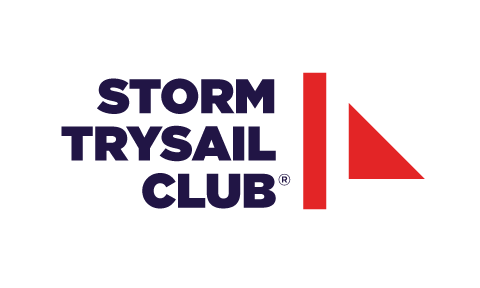Larchmont, NY – This past Sunday, Storm Trysail Club hosted 225 participants in its 2022 Adult Hands-On Safety At Sea at SUNY Maritime College in the Bronx. 70 STC volunteers oversaw clinics in pyrotechnics training, firefighting, damage control, personal flotation device activation/usage, liferaft deployment and embarkation, and Crew Overboard (COB) recovery. For many Newport-Bermuda Race participants, this seminar is the go-to event as it is the only seminar that puts the sailors on the water to practice real COB Recovery. Most of the participants are doing the Bermuda Race, but there are many who are coastal cruisers and club racers looking to improve their safety awareness and skills.
Rich du Moulin, Event Chair and Chair of the Storm Trysail Foundation, opened the general session with these words of caution: “No seminar is going to teach you competence. Seminars introduce you to ideas and practices. You can only achieve competence by practicing on your boat with your crew. Remember the Marine Corps phrase: ‘Train the way you fight; fight the way you train.’”
The Storm Trysail Safety at Sea event is the only safety seminar that provides training in a new COB recovery technique called the “Midline Lift.” (See following diagram.) Rich explains: “Once a COB is located, the biggest danger for them is being struck by the hull, or swept underneath. This technique virtually eliminates these risks. It is also highly suitable for reduced-manning situations such as double handing or 3 or 4 crew, where it is safer to keep the hull away from the COB. By clipping the spinnaker halyard shackle to the Lifesling rope, and then hoisting the halyard up, the victim is slowly and safely brought to the mid-beam of the boat – the safest location – and immediately lifted over the lifelines. The original Midline Lift concept uses specially trained and equipped rescue swimmers who swim out to the COB. Storm Trysail modified the technique to catch the MOB with a towed Lifesling, and then perform the lift.”
(For more information about the lift, visit HERE)
Kelly Robinson, the On-The-Water-Activities Chair, added “We practiced this technique using a an innovative ‘dummy man in the water’. These are dacron sailcloth bags with flotation devices that were devised by our own Charles “Butch” Ulmer. They fill with 180 pounds of seawater to simulate the weight of a real person in the water. This gives participants a more realistic experience than simply grabbing a lightweight pick-up stick.”
“In addition to the Midline Lift, participants also practiced as if the ‘dummy’ was unconscious or incapacitated, and unable to get into a Lifesling. To recover the ‘unconscious’ dummy, a Rescue Crew volunteer from each boat was placed in a bosun’s chair or harness and lowered over the side with a tether to attach to the dummy. Then the rest of the team onboard hoisted both the Rescue Crew and the dummy – it’s a lot of work as the combined weight is over 350 pounds! Special kudos to those who volunteered as Rescue Crew; the water this time of year is very cold, so everyone was wearing some form of cold weather immersion protection. Helmets and rescue PFDs (like fat dinghy vests) are recommended.”
The sessions in the pool were run by Dan O’Connor and quite instructive. For many, it’s the only time they have actually seen their automatic personal flotation devices inflate. Most years, there are a number that fail due to lack of maintenance, usually due to CO2 cylinders having been previously fired or not securely screwed in. Du Moulin reports that “In our 2021 seminar, only 2 out of 145 failed to automatically inflate. In this seminar we are still gathering the data, but it appears 3 out of 225 failed. This proves the value of annual inspections and the reliability of inflatable pfds when they are properly maintained.”
Everyone greatly benefited from the U.S. Coast Guard Air Station Cape Cod personnel who spent the entire day at the seminar, presenting Search and Rescue procedures and assisting in the pool, damage control, and acting as COB in the very cold water! Special thanks go out to Lt. Tanner Evans and ASTs Mike Kelly and Brian Notheis.
STC Commodore Ed Cesare stated “This very successful event is a difficult one to organize and execute. We incorporated a number of innovations and new lesson elements, and it all came to fruition flawlessly. These events take a tremendous amount of support – both financially and logistically. First, we’d like to thank our sponsors: Safe Harbor Marinas, AIG Insurance, McMichael Yacht Yards and Brokers, UK Sailmakers – especially Butch for making the dummies, Dimension-Polyant, Sea Safety International, Marine Safety Corporation, LRSE, Landfall Navigation and the Storm Trysail Foundation and its generous donors. We also would like to thank Rich du Moulin, Kelly Robinson, and our Executive Director Whitney Kneisley who did the planning and organizing, all of the volunteers, and incoming Event Chair Chris Huntington. This event could not succeed without Rob Crafa, SUNY Waterfront Director and Katie Frano, SUNY Conference Director. “
As part of Storm Trysail’s Safety and Educational outreach, this past March we partnered with the Bermuda Sloop Foundation to run a two-day Hands-On seminar in Bermuda with the hosting and venue kindly provided by the Royal Bermuda YC. Participants practiced damage control, pyrotechnics and MOB recovery techniques - including the midline lift from the main mast of the 110-foot three-masted training vessel Spirit of Bermuda! The 32 attendees included the crew of the vessel. This represents the first time Storm Trysail has run a seminar internationally.
Storm Trysail Club is presently filling out its calendar of Junior SAS events for the summer and planning a joint Hands-On Seminar with the Chicago Yacht Club in the Fall.
For a free digital copy of STC’s Safety at Sea Handbook, visit HERE
For the list of all Volunteers click HERE

